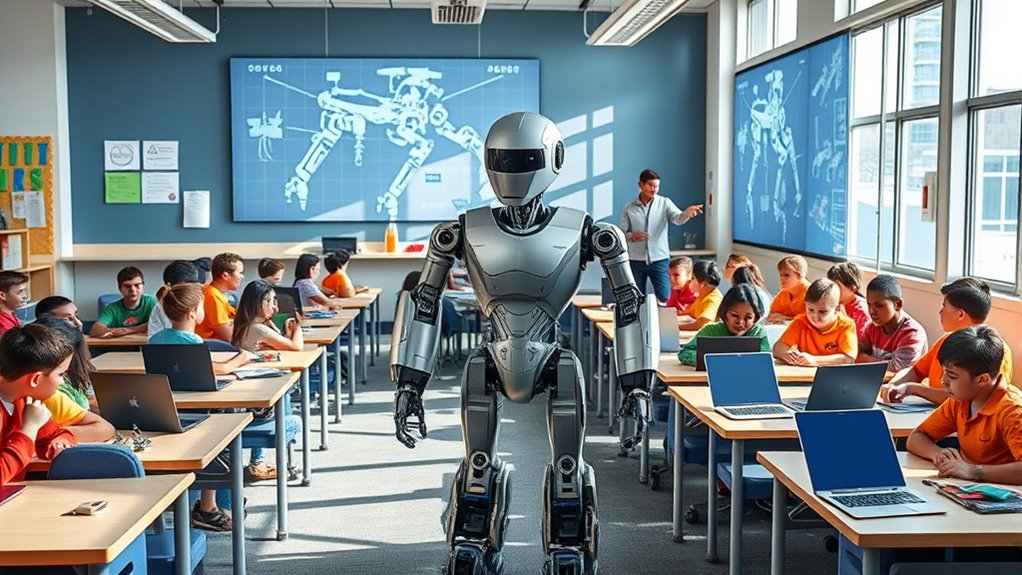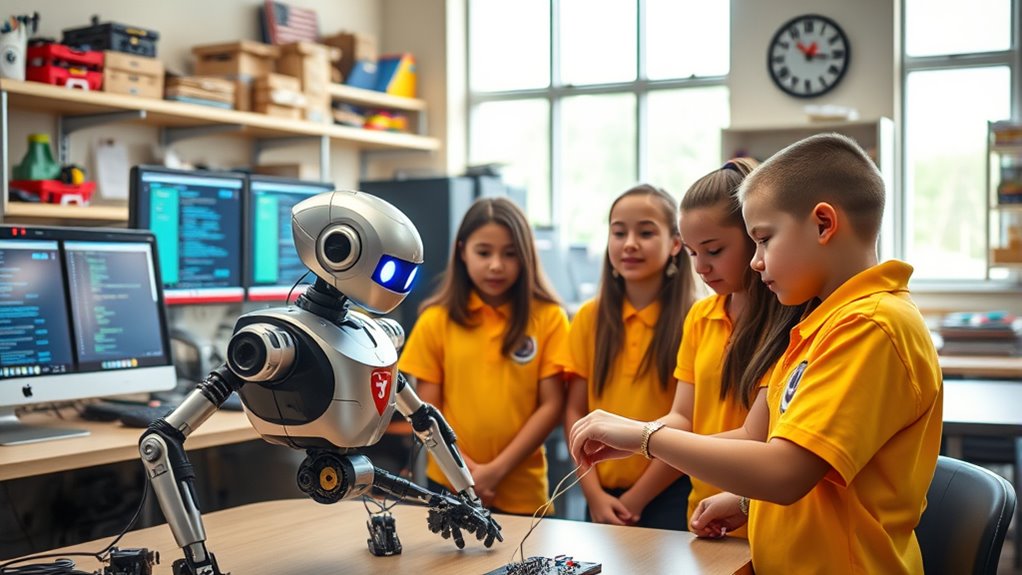A single Ohio classroom shows how full state support can spark real transformation in education and workforce readiness. By investing in robotics, STEM initiatives, and hands-on projects, you can equip students with essential skills for today’s tech-driven economy. This example proves that with strategic funding and commitment, classrooms can become hubs of innovation. If you keep exploring, you’ll discover how broader investments can unleash even greater potential across Ohio.
Key Takeaways
- A single Ohio classroom’s robotics success demonstrates how strategic investment can foster innovation.
- Full state commitment is essential to expand robotics programs and maximize educational transformation.
- Robotics initiatives improve student skills in coding, engineering, and teamwork, preparing them for a tech-driven economy.
- Integrating robotics into classrooms aligns with workforce needs, supporting economic resilience and automation readiness.
- Continued funding and support from the state can turn classrooms into hubs of innovation and technical excellence.

As you look at Ohio’s education landscape, you’ll notice a significant increase in students engaging with technical fields. About 25% of high school students participated in career and technical education (CTE) during 2022-2023, up from 16% a decade ago. The state heavily invests in robotics, cybersecurity, and manufacturing technology, recognizing these as essential for future workforce needs. Many students are choosing technical education paths that prepare them to enter the job market directly, reflecting Ohio’s strategic focus on workforce readiness. Robotics education is expanding as part of broader STEM initiatives, aligning classroom learning with the demands of a tech-driven economy. Regular maintenance and proper cleaning techniques are critical for ensuring the longevity and optimal performance of robotics equipment used in classrooms.
Robotics clubs and competitions further ignite student interest. The K12 Robotics League engages students from grades 4 through 12 in regional and national contests, promoting coding, engineering, and teamwork. These competitions, blending virtual and physical challenges, motivate students through recognition and prizes, making STEM fun and accessible. Ohio students are actively participating in these events, gaining hands-on experience that complements classroom instruction.
Ohio’s leading universities, such as Ohio State University and Case Western Reserve, contribute to the state’s robotics ecosystem through research and workforce development. They serve as pipelines for skilled engineers and innovators, collaborating with K-12 programs to ensure a seamless educational progression. With over 161,000 robotic engineering jobs projected nationally by 2025, Ohio’s focus on robotics education is essential. It’s a strategic move to build a resilient economy, ready to meet the demands of automation and AI. But this potential can only be realized if the state fully commits to expanding and funding these initiatives, transforming classrooms into hubs of innovation and skill-building.
Frequently Asked Questions
How Does Robotics Impact Student Learning Outcomes?
Robotics boosts your learning by considerably improving your STEM knowledge and coding skills, with increases of 67% and 89% respectively. It enhances cognitive abilities like reasoning and memory, especially in young learners, and keeps you engaged through hands-on activities. Using pre-assembled robots reduces technical barriers, allowing you to focus on concepts, leading to better understanding, higher motivation, and stronger interest in STEM careers.
What Is the Cost of Implementing Robotics in Classrooms?
Implementing robotics in classrooms costs between $20,000 and $80,000, depending on equipment, software, and infrastructure needs. You’ll spend on robotics kits, computers, software licenses, and maintenance, with prices varying based on quality and quantity. Additional costs include teacher training and potential classroom upgrades. While these investments can be significant, they’re essential for providing students with hands-on learning experiences that prepare them for future careers in technology.
Are There Training Programs for Teachers to Use Robotics?
Yes, there are excellent training programs designed for teachers to master robotics. You can participate in Ohio University’s “Train the Trainer” courses, which offer hands-on experience with FANUC robots, even if you’re new to the field. Industry partnerships like Yaskawa Academy provide flexible, accredited courses. Additionally, high schools offer multi-year pathways with industry-recognized certifications, helping you develop practical skills and confidently integrate robotics into your teaching.
How Do Students With Disabilities Benefit From Robotics Education?
You see how students with disabilities benefit from robotics education? They improve social-emotional skills by engaging with interactive robots that serve as social partners, boosting attention and calming behaviors. Robotics also motivates them to participate in STEM, builds confidence, and fosters teamwork. Tailored programming helps address individual needs, while immersive activities support focus and learning. Overall, robotics creates inclusive, supportive environments that enhance communication, social skills, and educational outcomes for students with disabilities.
What Partnerships Support Robotics Initiatives in Ohio Schools?
Imagine a network of bridges connecting islands of opportunity—that’s how Ohio schools support robotics initiatives through vibrant partnerships. You’ll find schools teaming with organizations like William Henry Harrison High School collaborating with Great Oaks, and Cleveland’s science center mentoring underserved youth. Colleges, nonprofits, and industry groups act as steady anchors, guiding students across these bridges toward STEM careers, ensuring every student has a pathway to innovation and success.
Conclusion
As you see, when Ohio fully commits to robotics education, transformation becomes inevitable. It’s no coincidence that classrooms, once limited, now thrive with innovation and curiosity. The timing feels right, almost serendipitous, as students embrace technology and skills that will shape their futures. With every robot built and challenge met, progress feels natural—like it’s meant to be. When the state invests wholeheartedly, the possibilities unfold effortlessly, proving that change is just a decision away.









